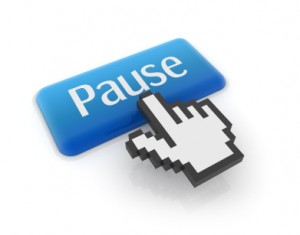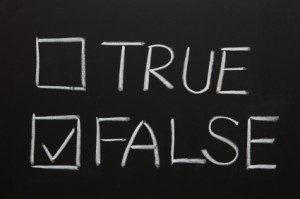Why Your Dog Is Happier Than You Are

The door’s opening!
Story 1: When I come home, I open the front door and our dachshund, Bella, comes racing through the house, throws herself at my feet, rolls over for a belly rub, and wags her tail vigorously. It doesn’t matter if I’ve been outside for a few minutes or away on a business trip for a few days. Bella’s reaction is always the same – she’s thrilled to see me.
Story 2: Suellen and I enjoy art and we’re friends with several artists, so we have a lot of artsy things – photographs, etchings, a few paintings, and sculptures. Some of it is pretty good stuff. Even the not-so-good stuff has lots of sentimental value. I notice, however, that I don’t notice the art so much. I can walk through the house without registering that it’s filled with art. It’s almost like wallpaper.
Why is it that Bella gets excited just by hearing the door creak open while I can blithely ignore some very stimulating art? I think it’s because of hedonic adaptation. I have it. Bella doesn’t.
When we acquire a new piece of art, I pay a lot of attention to it. I may study it, talk about it, maybe even brag about it. It’s new and different and it stimulates me. After a few months, however, it’s just part of the new normal. I still like the piece but it doesn’t stimulate me. I’ve adapted to its presence. That’s hedonic adaptation (or the hedonic treadmill as it’s sometime called).
Bella, on the other hand, doesn’t seem to grow accustomed to the same old thing. Everything seems new to her all the time. The door creaks and off she goes to a new adventure. At the very least, she’ll get a belly rub. She might even get a treat. Oh, it’s so exciting!
There’s a subtler difference as well. Art is a thing, something to be owned. An opening door is an experience: who knows what will happen? There’s a bundle of evidence that experiences generate more happiness than things. If you want to improve your general level of happiness (and perhaps get off the hedonic treadmill for a while), invest in doing things rather than buying things.
I’ve written about happiness before (click here and here and here). There’s a rising tide of research on Gross National Happiness and a suggestion that we over-emphasize Gross National Product in public policy. For instance, American wealth has tripled in the past half century but we haven’t gotten any happier. Relative wealth seems more important than absolute wealth.
What about at the personal level? The best advice seems to be to invest in small experiences. Why small rather than big? Because you can do them more often. Frequency seems to be more important than size. There’s a novelty factor that seems to intrigue and stimulate us. Bottom line: do more things, buy fewer things. Oh, and get a dog.
Want a Good Decision? Go to Trial.

We all know what the decision should be.
Let’s say that you’re arrested for a terrible crime. After a few months in jail, you’re taken to court for a trial. In the courtroom, you meet your lawyer for the first time. The judge selects a jury. You notice that all the jurors are white males and that they all went to the same business school.
As the trial begins the judge tells the jurors – very directly – that she believes you’re guilty. The prosecutor then uses Power Point to present the evidence against you. The presentation consists of over 200 slides.
Your lawyer is not allowed to present any evidence – he can only respond to the prosecutor’s slides. He raises a number of objections but the prosecutor handles each one smoothly. You notice that the prosecutor doesn’t refute the objections but merely brushes them aside. The slides are complicated and hard to follow. You notice that some of the jurors are glassy-eyed. Others are checking their BlackBerries.
When the prosecutor’s presentation concludes, the jurors don’t adjourn to a separate room to discuss the case. Rather, the judge simply asks them, “So, do you agree with me?” Most of the jurors nod their heads and you’re whisked off to jail.
Could that really happen? Let’s hope not in a court of law. But, as Chip and Dan Heath point out in their book, Decisive, that’s exactly how corporations make bazillion dollar decisions. Echoing Paul Nutt’s book, Why Decisions Fail, the Heaths point out that most business decisions really are one sided.
Here’s how it goes. An executive gets an idea that just might be brilliant – or not. Then a process begins to justify the idea and convince top management to support it. Most of the members of top management recognize that a justification process is going on. They don’t really object to it because 1) they don’t have a forum to present their ideas; and 2) they don’t have the resources to develop the other side of the story or to investigate alternatives.
The justification process grinds on. As the Heaths point out, the process usually results in a “whether or not” decision. Executives don’t consider a range of alternatives but simply vote up or down, yes or no.
The process usually includes a top management meeting with a barrage of Power Point slides. I’ve participated in dozens of them. Usually someone in the meeting says, “Well, let me play devil’s advocate for a moment ….” No matter what that person says, the objection is somehow handled and brushed aside. The devil’s advocate may have a good point but he doesn’t have the data to back it up. The result is that the group feels “better” about the decision … “after all, we did consider both sides.”
Paul Nutt writes that business “…decisions fail half of the time. Vast sums are spent without realizing any benefits for the organization.” In other words, we could flip a coin and do just as well – and save a bundle on consulting fees.
We often complain about our judicial system. But the trial by jury – with evenly matched sides presenting evidence – is probably the best system ever developed for discerning the truth when the evidence is murky. In business, the evidence is often murky; we’re trying to predict the future with incomplete data. You want the best decision? Put it on trial.
My Strategic Pause
 It’s true. Every now and then, I get annoyed. I have a fairly long fuse but, when I get to the end of it, I become agitated, irritable, snarky, and overbearing.
It’s true. Every now and then, I get annoyed. I have a fairly long fuse but, when I get to the end of it, I become agitated, irritable, snarky, and overbearing.
I find that about half the time when I get to that stage, it’s because something external to me got me there. Another person gets my goat. Someone else screws up and I’m left holding the bag. A mechanical failure delays yet another flight and, no, I can’t get home tonight. As the saying goes, if it’s not one thing, it’s your mother.
If external factors cause about half of my annoyance attacks, where do the other half come from? Well …. from me. How do I know this? Because I keep track of my flaming e-mails. I live a lot of my life online. I process roughly 100 to 150 e-mails per day.
When I’m annoyed, I sometimes send flaming e-mails. It just feels good to send a self-righteous missive excoriating the recipient for innate stupidity. “Were you born stupid or is this a recent development?” About half the time, my analysis is correct (though my tactics are self-defeating). The other half of the time, I ultimately find out that my own stupidity caused the problem. I failed to check a box, or fill in a blank, or submit the paperwork on time and, therefore, it’s my fault. Then I really feel stupid.
So now when I get to the end of my rope, I take a strategic pause. That’s a fancy term that comes from the critical thinking world but it’s a technique that we all learned in grade school: count to ten before you start throwing fists.
Actually, I do more than count to ten. Here’s a summary of my thinking:
“OK, I’m really annoyed. I know that when I’m annoyed, I don’t always think clearly. I also know that about half the time when I’m annoyed, it’s my own damn fault. So, how am I going to figure out: a) who or what caused this annoyance; b) what I’m going to do about it? I might need some facts here.”
Then I turn to my “go-to” questions. I call them “go-to” questions because I’ve used them often enough that they’re always with me. I may forget the rules of logic, but I can always go to these questions. There are four of them. The first two are for me. I use the last two only after considering the first two and only if there is another person involved in the annoyance incident.
The first two are simply:
- How do I know that?
- Why do I think that?
By asking these two questions, I can go back to the beginning, recount the process that got me to where I got to, and decide whether I’m on firm ground or not. If not, I can start to make corrections. If I am on firm ground, I can ask the next two questions (of the other person):
- How do you know that?
- Why do you think that?
These questions have helped me avoid countless misunderstandings. I might say, “Why do you think that?” The other person might say, “Because you said XYZ.” I might then say, “Actually, I didn’t say XYZ. I said ZYX.” Rather than shooting first and asking questions later, we can ask questions and perhaps avoid shooting altogether. It’s a simple approach that often stops an argument before it comes to a boil.
I’ve developed my go-to questions based on years of experience. I always advise my critical thinking students to develop their own go-to questions. In class, we often discuss which questions are most effective in a strategic pause. So, now you can help me teach my class. What are your most effective go-to questions?
How Many Intelligences Do You Need?
When driving home from a party, I may ask Suellen a question like, “Why did Pat make that cutting remark about Kim?” Suellen will then launch into a thorough exegesis about relationships, personal histories, boyfriends, girlfriends, children, parents, gardening, the nature of education, and the tangled web we weave when first we practice to deceive. In the end, it will all make sense — even to me, a socially challenged kind of guy.
Suellen is great at answering questions like these. It’s often referred to as social or emotional intelligence. It’s about people and relationships and empathy. I’m generally better at academic intelligence and questions like how do you calculate the volume of a sphere? (I don’t mean to say that I’m better at academic intelligence than Suellen is … but that I’m better at academic intelligence than I am at social intelligence. I hope that’s clear… I wouldn’t want my lack of social intelligence to lead me to insult my own wife.)
For me, two intelligences — academic and social — have been quite enough. But not for Howard Gardner. In Five Minds for the Future, Gardner suggests that there are five different intelligences and, if education is to succeed in the future, we need to teach them all.
I’m fairly well versed in the tenets of critical thinking. Now I’m trying to understand Gardner’s theory of multiple intelligences. Why? Because I’d like to mash up critical thinking and multiple intelligences. I’m wondering if critical thinking works the same way in each intelligence. Can you think critically in say, academic intelligence, while thinking uncritically in social intelligence? That’s certainly the stereotype of the absent-midned professor.
To mash up critical thinking and the five minds, let’s first look at Gardner’s theory. The five minds are:
Disciplined mind — to master the way of thinking associated with a specific discipline — say, economics, psychology, or mathematics. I think (hope) it’s also broader than that. I’m certainly trained in the Western way of thinking. I categorize and classify things without even thinking about it. I’m now looking at Zen as a different way of thinking — one that destroys categories rather than creates them. That’s certainly a different discipline.
Synthesizing mind — the ability to put it altogether. Gardner points out that memorization was important in times characterized by low literacy. In today’s era of Big Data, synthesis is much more important and memorization much less important.
Creating mind — proposing new ideas, fresh questions, unexpected answers. As I’ve noted before in this blog, a new idea is often a mashup of multiple existing ideas. To propose something that doesn’t exist, you need to be well versed in what does exist.
Respectful mind — “… notes and welcomes differences between human individuals and between human groups….” This is very similar to the concept of fair mindedness as used in critical thinking. This could be our first mashup.
Ethical mind — how can we serve purposes beyond self-interest and how can “citizens…work unselfishly to improve the lot of all.” Again, this is quite similar to concepts used in critical thinking, including ethical thinking and the ability to overcome egocentric thinking.
Today, I simply want to introduce Gardner’s five minds. In future posts, I’ll try to weave together critical thinking, Gardner’s concepts of multiple intelligences, and the Hofstedes’ research on the five dimensions of culture. I hope you’ll tag along.
By the way, the volume of a sphere in 4/3∏r³.
How Do You Know If Something Is True?
 I used to teach research methods. Now I teach critical thinking. Research is about creating knowledge. Critical thinking is about assessing knowledge. In research methods, the goal is to create well-designed studies that allow us to determine whether something is true or not. A well-designed study, even if it finds that something is not true, adds to our knowledge. A poorly designed study adds nothing. The emphasis is on design.
I used to teach research methods. Now I teach critical thinking. Research is about creating knowledge. Critical thinking is about assessing knowledge. In research methods, the goal is to create well-designed studies that allow us to determine whether something is true or not. A well-designed study, even if it finds that something is not true, adds to our knowledge. A poorly designed study adds nothing. The emphasis is on design.
In critical thinking, the emphasis is on assessment. We seek to sort out what is true, not true, or not proven in our info-sphere. To succeed, we need to understand research design. We also need to understand the logic of critical thinking — a stepwise progression through which we can discover fallacies and biases and self-serving arguments. It takes time. In fact, the first rule I teach is “Slow down. Take your time. Ask questions. Don’t jump to conclusions.”
In both research and critical thinking, a key question is: how do we know if something is true? Further, how do we know if we’re being fair minded and objective in making such an assessment? We discuss levels of evidence that are independent of our subjective experience. Over the years, thinkers have used a number of different schemes to categorize evidence and evaluate its quality. Today, the research world seems to be coalescing around a classification of evidence that has been evolving since the early 1990s as part of the movement toward evidence-based medicine (EBM).
The classification scheme (typically) has four levels, with 4 being the weakest and 1 being the strongest. From weakest to strongest, here they are:
- 4 — evidence from a panel of experts. There are certain rules about such panels, the most important of which is that it consists of more than one person. Category IV may also contain what are known as observational studies without controls.
- 3 — evidence from case studies, observed correlations, and comparative studies. (It’s interesting to me that many of our business schools build their curricula around case studies — fairly weak evidence. I wonder if you can’t find a case to prove almost any point.)
- 2 — quasi-experiments — well-designed but non-randomized controlled trials. You manipulate the independent variable in at least two groups (control and experimental). That’s a good step forward. Since subjects are not randomly assigned, however, a hidden variable could be the cause of any differences found — rather than the independent variable.
- 1b — experiments — controlled trials with randomly assigned subjects. Random assignment isolates the independent variable. Any effects found must be caused by the independent variable. This is the minimum proof of cause and effect.
- 1a — meta-analysis of experiments. Meta-analysis is simply research on research. Let’s say that researchers in your field have conducted thousands of experiments on the effects of using electronic calculators to teach arithmetic to primary school students. Each experiment is data point in a meta-analysis. You categorize all the studies and find that an overwhelming majority showed positive effects. This is the most powerful argument for cause-and-effect.
You might keep this guide in mind as you read your daily newspaper. Much of the “evidence” that’s presented in the media today doesn’t even reach the minimum standards of Level 4. It’s simply opinion. Stating opinions is fine, as long as we understand that they don’t qualify as credible evidence.


